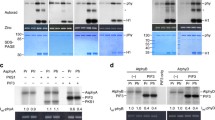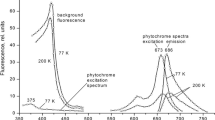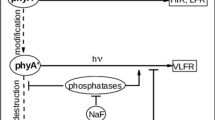Summary
The present paper is a contribution to the “molecular” analysis of photomorphogenesis. L-phenylalanine ammonia-lyase (=PAL) (EC 4.3.1.5) has been used as a model system to demonstrate that enzyme synthesis, enzyme inactivation and gene repression are important in determining the response of a particular enzyme to phytochrome.
The level of PAL in the mustard seedling is controlled by Pfr (the active form of phytochrome) in a characteristic manner which is illustrated in Fig. 1. The seedlings were irradiated with continuous standard far-red light. Long time irradiation with far-red will maintain a low but virtually constant level of the effector molecule Pfr in the seedling over an extended period of time. At the moment when the far-red light is turned off the action of Pfr will instantly decrease and will eventually cease probably within the order of an hour (cf. Karow and Mohr, 1969). The approach followed in the present paper has been to turn off the far-red light after varying periods and follow the enzyme kinetics in darkness (Fig. 2). The main results can be summarized as follows: The far-red kinetics of PAL (Fig. 1) can be explained as the result of three processes, namely, Pfr-mediated enzyme synthesis, inactivation of PAL by an “inactivator”, and eventual repression of enzyme synthesis.—During the period 1.5–12 hrs after the onset of far-red only enzyme synthesis occurs. Then enzyme inactivation comes into play while enzyme synthesis continues at a constant rate (Fig. 3). This antagonism of synthesis and inactivation leads to a true steady state which is observed between about 24 and 27 hrs after the onset of far-red. After this period the rate of enzyme synthesis decreases and as a consequence, inactivation dominates. 36 hours after the onset of far-red the Pfr-mediated PAL synthesis is hardly dtectable. The results of “secondary irradiations” with far-red (Fig.4) indicate that the “inactivator” of PAL does not have any direct influence on PAL synthesis. The kinetics in darkness (Fig.1,2) can best be understood by assuming that a certain enzyme level represented by the plateau cannot be overcome in the dark. The “overshoot” response which is obvious in the enzyme kinetics immediately after the cessation of far-red (Fig. 2) cannot be explained readily in molecular terms.
Similar content being viewed by others
Literatur
Durst, F., and H. Mohr: Phytochrome-mediated induction of enzyme synthesis in mustard seedlings (Sinapis alba L.) Naturwissenschaften 53, 531–532 (1966).
Engelsma, G.: Effect of cycloheximide on the inactivation of phenylalanine deaminase in gherkin seedlings. Naturwissenschaften 54, 319–320 (1967).
—: Photoinduction of phenylalanine deaminase in gherkin seedlings. III. Effects of excision and irradiation on enzyme development in hypocotyl segments. Planta (Berl.) 82, 355–368 (1968).
Hartmann, K. M.: Phytochrome 730 (Pfr), the effector of the “high energy photomorphogenic reaction” in the far-red region. Naturwissenschaften 54, 544 (1967a).
Hartmann, K. M. Photoreceptor problems in photomorphogenic responses under high-energyconditions (UV-blue-far-red). Book of Abstracts, European Photobiology Symposium, Hvar (Jugoslavia) 1967b, p. 29–32
Havir, E. A., and K. R. Hanson: L-Phenylalanine ammonia-lyase. I. Purification and molecular size of the enzyme from potato tubers. Biochemistry 7, 1896–1903 (1968a).
—: L-Phenylalanine ammonia-lyase. II. Mechanism and kinetic properties of the enzyme from potato tubers. Biochemistry 7, 1904–1914 (1968b).
Karow, H., and H. Mohr: Phytochrome-mediated repression of enzyme increase (lipoxidase, EC. 1.13.1.13.) in mustard seedlings (Sinapis alba L.) Naturwissenschaften 56, 94 (1969).
Kenney, F. T.: Turnover of rat liver tyrosine transaminase: Stabilization after inhibition of protein synthesis. Science 156, 525–528 (1967).
Marsh, H. V., E. A. Havir, and K. R. Hanson: L-Phenylalanine ammonia-lyase. III. Properties of the enzyme from maize seedlings. Biochemistry 7, 1915–1918 (1968).
Mohr, H.: Untersuchungen zur phytochrom-induzierten Photomorphogenese des Senfkeimlings (Sinapis alba L.). Z. Pflanzenphysiol. 54, 63–83 (1966).
—: Photomorphogenesis. In: The physiology of plant growth, development and responses (M. B. Wilkins, edit.). Maidenhead, Berks: McGraw-Hill, Publ. Co. 1969.
— C. Huault, H. Lange, L. Lohmann, I. Rissland, and M. Weidner: Lag-phases in phytochrome-mediated enzyme synthesis (PAL). Planta (Berl.) 83, 267–275 (1968).
Reel, J. R., and F. T. Kenney: “Superinduction” of tyrosine transaminase in hepatoma cell cultures: Differential inhibition of synthesis and turnover by Actinomycin D. Biochemistry 61, 200–206 (1968).
Rissland, I., u. u. H. Mohr: Phytochrom-induzierte Enzymbilding (Phenylalanindesaminase), ein schnell ablaufender Prozeß. Planta (Berl.) 77, 239–249 (1967).
Schimke, R. T., R. Ganschow, D. Doyle, and J. M. Arias: Regulation of protein turnover in mammalian tissues. Fed. Proc. 27, 1223–1230 (1968).
Wagner, E., and H. Mohr: Kinetic studies to interpret “high energy phenomena” of photomorphogenesis on the basis of phytochrome. Photochem. Photobiol. 5, 397–406 (1966a).
—: Primäre und sekundäre Differenzierung im Zusammenhang mit der Photomorphogenese von Keimpflanzen (Sinapis alba L.) Planta (Berl.) 71, 204–221 (1966b).
Weidner, M.: Der DNS-Gehalt von Kotyledonen und Hypokotyl des Senfkeimlings (Sinapis alba L.) bei der phytochromgesteuerten Photomorphogenese. Planta (Berl.) 75, 94–98 (1967).
— I. Rissland, and H. Mohr: Photoinduction of phenylalanine ammonialyase in mustard seedlings: Involvement of phytochrome. Naturwissenschaften 55, 452 (1968).
Zucker, M.: Sequential induction of phenylalanine ammonia-lyase and a lyase —inactivating system in potato tuber disks. Plant Physiol. 43, 365–374 (1968).
Author information
Authors and Affiliations
Additional information
PAL=Phenylalaninammoniumlyase (EC 4.3.1.5).
Diese Arbeit ist Herrn Professor H. Borris, Greifswald, mit guten Wünschen zum 60. Geburtstag gewidmet.
Rights and permissions
About this article
Cite this article
Weidner, M., Rissland, I., Lohmann, L. et al. Die Regulation der PAL-Aktivität durch Phytochrom in Senfkeimlingen (Sinapis alba L.). Planta 86, 33–41 (1969). https://doi.org/10.1007/BF00385301
Received:
Issue Date:
DOI: https://doi.org/10.1007/BF00385301




